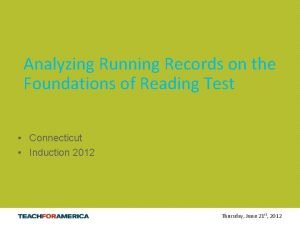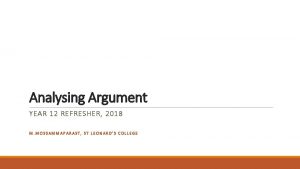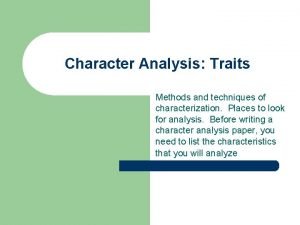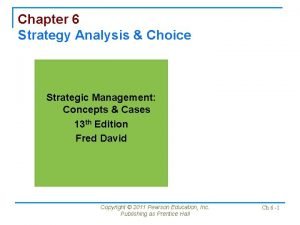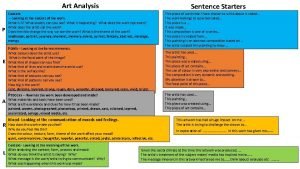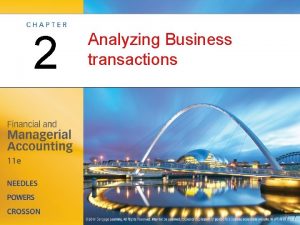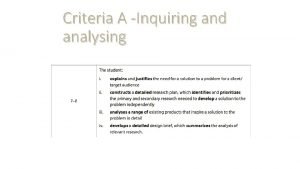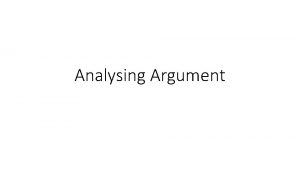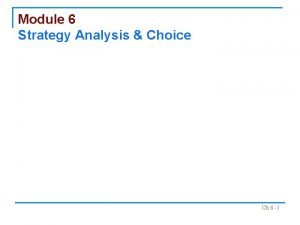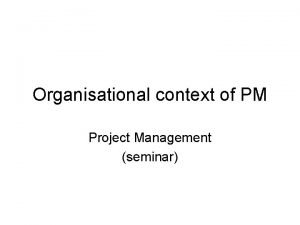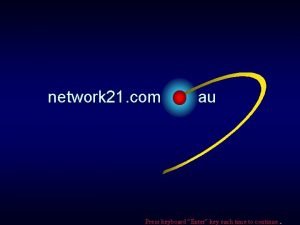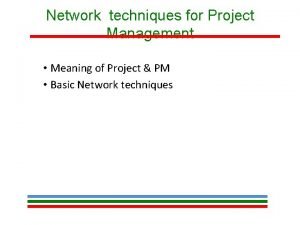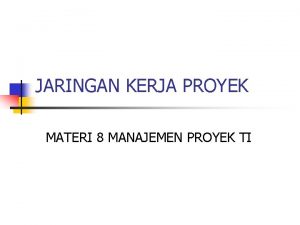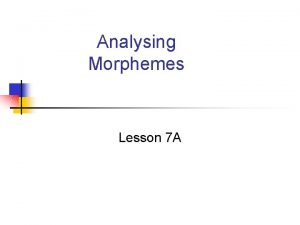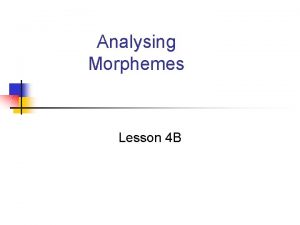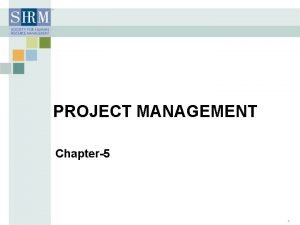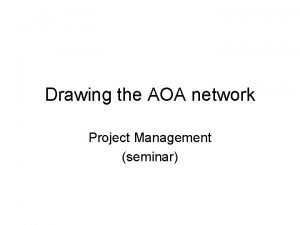Analysing the Ao N network Project Management seminar


















- Slides: 18

Analysing the Ao. N network Project Management (seminar)

Data on the activity node EST Total Float EFT Activity label & description LST Duration LFT

Total Project Time • The shortest time in which the project can be completed. Determined by the critical path. • Calculation: forward pass Forward pass: The earliest start times (EST) of all activities are calculated. Trom these the earliest finishing times (EFT) are also calculated

Critical path • sequence of activities that has no float time, and that determines the duration of the project. It is the longest path. Activities on the critical path are the critical activities. • The critical path can be identified by a backward pass, calculating the Latest Finishing Times (LFT), and from these the Latest Starting Times (LST).

Floats in Ao. N • Total float: the time by which an activity can be delayed or extended without affecting the TPT. It can be used to delay the start of an activity or to increase its duration. TF = LST - EST • Free float: the time by which an activity can be delayed or extended without affecting the start of any succeding activity. FF = ESTj+1 EFTj

Example: organising a conference • Objectives: to organise a 3 days long open scientific conference with 100 -200 participants, 30 -50 lectures, buffet reception, a conference book of the best studies and TV and radio interviews with some of the most known lecturers. • Create the WBS chart and create the task list with estimated durations and precedence relations (in a table form) • Plot both the Ao. A and Ao. N diagram • Calculate the TPT, identify the critical path the total and the free float times.

Example: WBS Project Event management Book Editing Publishing Collecting articles Peer reviewing Infrastructure Facilities Organising participants Staff Marketing Arranging event Materials Invitation and marketing Organising interviews

Task list with precedence relations Activity label Task description Duration (weeks) Immediate predecessors a Invitation 2 – b Organising participants 4 a c Facilities 3 b d Staffing 4 b e Materials 3 b hf Collecting articles 6 b gj Peer reviewing 3 f h k Publishing interviews Organising 5 1 c, d, e il Organising interviews Publishing 1 5 g Arranging event 1 h, i m j

Ao. A 4 19 9 3 c 1 0 0 2 a 2 2 2 4 b 3 6 4 d 6 5 19 10 3 e 6 19 10 6 5 i f 7 12 12 1 h 3 g 8 15 15 9 20 20 1 10 j 21 TPT = 21 CP: a-b-f-g-i-j 21

Ao. N 1 6 10 9 c 16 0 0 0 2 2 2 0 6 b 2 19 0 a 0 3 2 4 6 10 10 9 15 4 11 20 h d 6 0 9 1 19 19 10 20 20 9 0 e 16 3 15 6 0 12 0 15 12 f 6 6 0 20 12 3 5 20 15 g 12 0 i 19 0 15 21 j 1 6 0 TPT: 21 CP: a-b-f-g-i-j 1 21

Activity times for the previous diagram (continue individually) Activity Duration EST LST EFT LFT Total float Free float a 2 0 2 0 0 b 4 2 6 0 0 C 3 6 9 16 19 10 1 d e f g h i j

Example 2 (for individual practice) a) Draw the Ao. A and Ao. N diagram with the data below: Activity label Duration (weeks) Immediate predecessors a 1 – b 2 a c 5 a d 3 a e 2 b f 2 e g 4 f, c, d b) Determine the TPT and the critical path and activity floats. c) Compute the EETs, LETs and slack for every node in the Ao. A & ESTs, LSTs, EFTs, LFTs in the Ao. N diagram.

Solution: Ao. A Float: 0 3 2 b Float: 0 3 5 2 e 3 1 0 Slack: 0 1 a Float: 0 2 1 5 c 1 2 f 5 Float: 0 Slack: 0 0 5 6 T. float: 1 F. float: 1 Slack: 0 7 7 Slack: 0 3 d T. float: 3 F. float: 3 4 4 4 g Float: 0 7 11 Slack: 0 0 7 Slack: 3 11 TPT: 11 CP: a-b-e-f-g

Solution: Ao. N 0 1 0 3 3 b 1 2 0 0 1 3 3 1 5 2 0 7 f 2 5 2 7 0 1 1 a 0 5 e 0 0 1 6 7 2 5 11 g c 1 0 7 7 4 11 3 4 d 4 3 7 TPT: 11 CP: a-b-e-f-g

Example 3 2 b 1 0 0 2 a 2 3 5 5 3 e 5 5 c 2 2 0 4 2 5 3 d 8 7 1 f 8 4 g 6 12 14 2 h a) Calculate the EETs and LETs. b) Create a precedence table (with task, duration, immediate predecessor, total and free floats). 14 14

Solution Activity Duration Total float Free float a 2 0 0 b 2 0 0 C 5 1 1 d 3 3 3 e 3 0 0 f 1 5 5 g 4 0 0 h 2 0 0

Readings • Lockyer – Gordon (2005) Chapter 14.

Thanks for the attention!
 Running record codes
Running record codes Analogy political cartoon
Analogy political cartoon Argument analysis structure
Argument analysis structure Analysing consumer market
Analysing consumer market The prohibited chow pest
The prohibited chow pest Character traits method
Character traits method Chapter 6 strategy analysis and choice
Chapter 6 strategy analysis and choice Art evaluation sentence starters
Art evaluation sentence starters Analysis of business transactions
Analysis of business transactions Inquiring and analysing
Inquiring and analysing Analysing the 6 strategic options megxit
Analysing the 6 strategic options megxit Analysing argument
Analysing argument Analysing the 6 strategic options megxit
Analysing the 6 strategic options megxit Analysing market data
Analysing market data Project management seminar
Project management seminar Importance of software project management
Importance of software project management Amway business plan presentation using network 21 system
Amway business plan presentation using network 21 system What is network techniques for project management
What is network techniques for project management Proyek jaringan komputer
Proyek jaringan komputer
